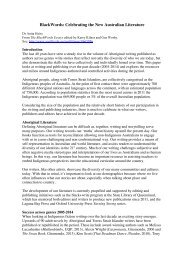7209743364812265548-Aboriginal-Literature-for-Children
7209743364812265548-Aboriginal-Literature-for-Children
7209743364812265548-Aboriginal-Literature-for-Children
Create successful ePaper yourself
Turn your PDF publications into a flip-book with our unique Google optimized e-Paper software.
The story combines adventure with the significance and responsibilities of a young person’scoming of age, and highlights the role of storytelling in <strong>Aboriginal</strong> culture to pass on specificand important in<strong>for</strong>mation of survival and history. The survival skills of Warabul andKutabah are indeed tested when they find themselves separated from their extended familyand must make their own way to their grandmother’s homeland.The moral to this story is not only the importance of storytelling in Indigenous communitiesthough, but also the role of story-listening! It was Warabal and Kutabah listening intently toNana Garna’s stories that ensured they found her country later on when they had no Eldersaround to guide them on their way. Their safe arrival in the ranges meant they passed theirfirst test and were well on their way to adulthood.Incorporating a Yindinji language wordlist, the author dedicates the book to, among others,the stranger who gave her her first story book Emanuel, and reminds the reader of thesignificance of books <strong>for</strong> young people.Another story with a moral is the popular children's book The Mark of the Wagarl, firstreleased in 2004 (and re-released in 2011), written by Lorna Little, Elder of the BinjarebNoongar community in Western Australia. In this title the author passes on some of hercultural knowledge about the Sacred Water Snake. The story tells of the travels andresponsibilities of Wagarl, the big boss of all snakes and how he keeps the waterways cleanin Noongar Country. But the story is essentially a moral tale about obedience, teaching youngpeople to respect and listen to their Elders. We learn, through the misadventures of the youngboy Baardi, what can happen when the wisdom of Elders is not heeded.Rather than avoiding Wagarl as advised by his Elders, Baardi dives right into the waterholeand deep into the cave under the big rivergum where Wagarl lives. Un<strong>for</strong>tunately, the youngfella suffers life-long consequences <strong>for</strong> disobeying the Elders and disturbing the Wagarl.Little says of writing this book:The children are my reason <strong>for</strong> writing this story. They have impressed upon me theimportance of recording the stories of our people <strong>for</strong> their cultural identity andstrengthening, so that they may pass them on to their children and grandchildren.They are strong in their desire to share stories with their wadjella friends to leadtowards a better understanding of Nyoongar culture.The Mark of the Wagarl was illustrated by Little’s niece, Perth-based visual arts studentJanice Lyndon, who has painted from an early age and draws inspiration from her Elders andthe environment, and this book is her debut into the publishing world.A simple moral also emerges in Two Mates (Magabala, 2012) a story that revolves around thedouble-message that friendship knows no boundaries, least of all boundaries of race ordisability. Two Mates was written by Melanie Prewett and illustrated by Maggie Prewett(both descended from the Ngarlumu people of the Pilbara region of Western Australia). It isbased on the true story of two young boys—Jack (Indigenous) and Raf (non-Indigenous) —and of how their mateship plays out in their coastal town of Broome. Together they search <strong>for</strong>hermit crabs, go hunting <strong>for</strong> barni (goanna), fish <strong>for</strong> salmon, explore the markets, eat sataysand dress up as superheroes. The reader only learns at the end of the story, via an illustration,




